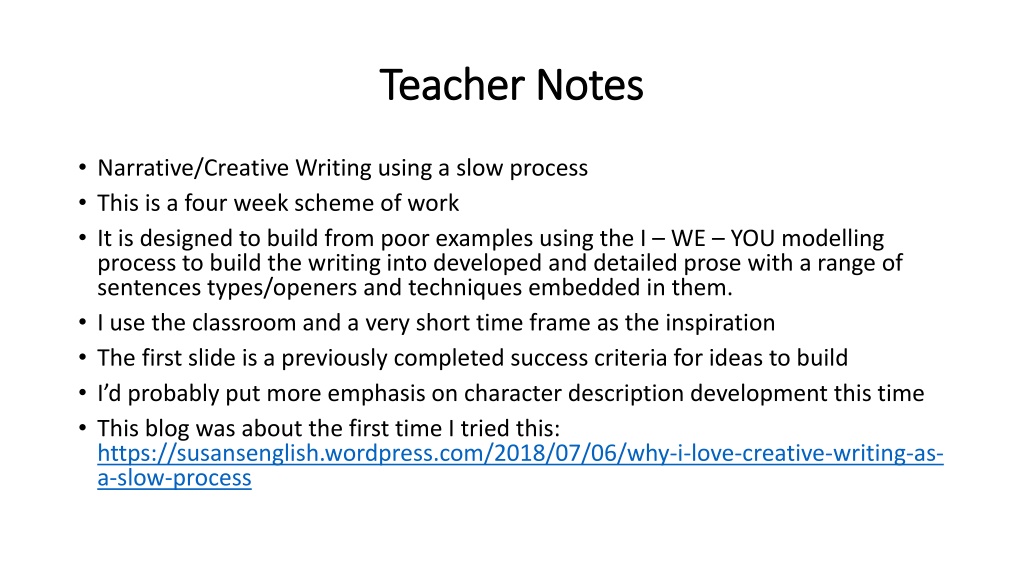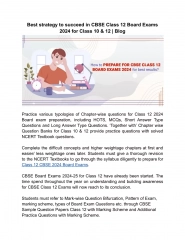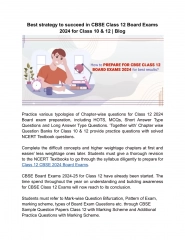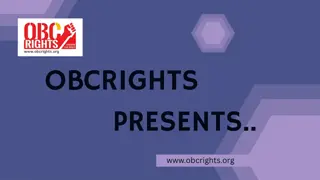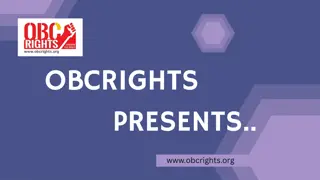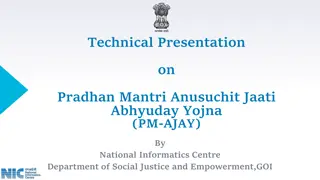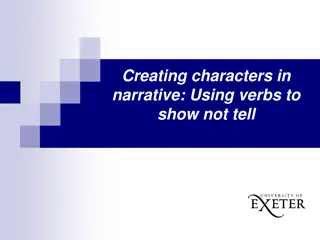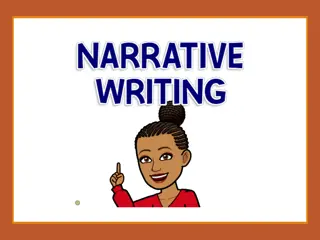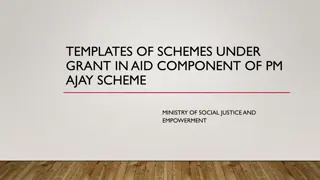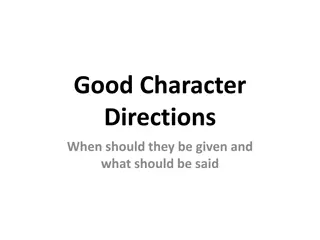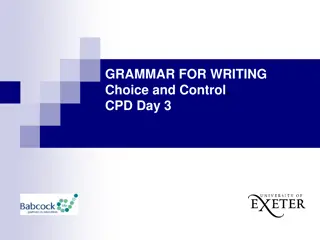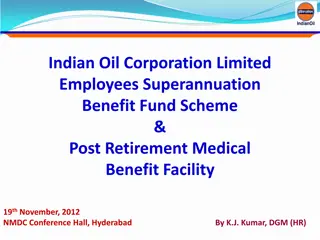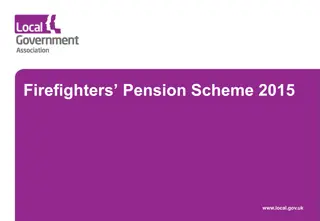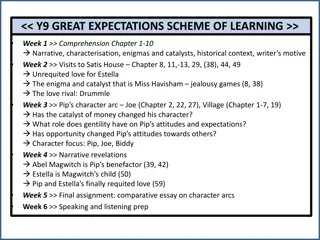Engaging Narrative Writing Scheme for Character Development
Embark on a four-week narrative writing scheme focusing on character development through a slow process. Utilize modeling techniques and diverse sentence structures to enhance prose quality. Explore key elements like withholding information, building climactic scenes, and crafting memorable conclusions. Encourage creative expression while emphasizing detailed description and emotional depth in storytelling.
Download Presentation

Please find below an Image/Link to download the presentation.
The content on the website is provided AS IS for your information and personal use only. It may not be sold, licensed, or shared on other websites without obtaining consent from the author. Download presentation by click this link. If you encounter any issues during the download, it is possible that the publisher has removed the file from their server.
E N D
Presentation Transcript
Teacher Notes Teacher Notes Narrative/Creative Writing using a slow process This is a four week scheme of work It is designed to build from poor examples using the I WE YOU modelling process to build the writing into developed and detailed prose with a range of sentences types/openers and techniques embedded in them. I use the classroom and a very short time frame as the inspiration The first slide is a previously completed success criteria for ideas to build I d probably put more emphasis on character description development this time This blog was about the first time I tried this: https://susansenglish.wordpress.com/2018/07/06/why-i-love-creative-writing-as- a-slow-process
Introduction: How can we make it engaging? Withhold information Short sentences for dramatic effect Question to start Open on a cliff-hanger in the middle of the action Use pathetic fallacy (the weather to set the mood) Show what is happening don t just tell Climax: Dramatic scene Some kind of fight/argument Something needs to happen Something unexpected happens Something naughty The Title: A Memorable Event Conclusion: Needs to link to the rest of your story Be memorable Can resolve the problem or leave it on a cliff-hanger Leave your story with something memorable Use a technique: ellipsis, question or exclamation mark Build Up: Key points for interesting writing: Not to give away too much information Imagery E.g. personification, imagery, simile and metaphor Use the senses throughout How for emotions = use adverbs to develop what feelings you want to create Building a mood using pathetic fallacy Vary sentence starters effectively: no I, the, it, she, he to open Use PANIC for opening sentence starters Preposition, Adjective/adverb, Noun, Ing words, Connective You must self-edit WHOLE STORY: Develop detailed description across the story You want your reader to be engaged with your character/events Check SPAG Sentences are varied simple, complex and compound Check you have not missed words out of the sentence TIPTOP your paragraphs It must be believable and engaging
Slow Planning Narrative/Creative Title: A Memorable Event Planning: Overall structure introduction rising action climax resolution Year 10 classroom something must happen it is restricted to one lesson only so the action must happen in the space of 1 hour I will model on the board my planning/thought process for a story with the title memorable event that happens in my classroom. We will discuss some ideas about this type of story and create a group plan. You will come up with your own plan.
The Power of Nouns Task: Noun words that give names to objects Building an image through nouns showing not telling Stella Artois Fist Tattoos Pub Think What do these nouns make you think and why? Apply Write a character description using these nouns to show not tell what the character is like. Merlot Manicure Handbag Mobile Phone Purse Squash Football Boots Grass Rocking Horse Lullaby Cry Tail Black Ears Meow Wrinkles Doctor Coat - Stethoscope Scarred Long Hair Motorbike Leathers
Y10 Plans Y10 Plans The I Plan Intro Y10 enter the class teacher s final lesson before moving schools teacher & 30 Y10 students Rising Action Hard to settle noisy disruptive bubbly class teacher wishes to teach and have a final nice lesson Climax Tall student gets up from seat after being insulted by another student & starts a water fight chaos ensues Resolution Teacher screaming and separating kids bell goes they walk out asking why are you leaving?
Y10 Plans Y10 Plans The We Plan Intro Walk in teacher sends us out straight away (angry from last class) Rising Action Children start arguing and are sent back into class (still unsettled) Climax Teacher loses control goes bright red and cries in front of the class Resolution Teacher resigns too much stress
Slow Planning Character/setting/mood/atmosphere Title: A Memorable Event Development of an interesting opening/character ALMA What is the weather like? (terminology for this) Where is the story set? What happens in the Introduction Rising Action Climax Resolution? How do we understand the thoughts, feelings and emotions of the character? How is a circular plot used?
Slow Planning Character/setting/mood/atmosphere Success Criteria discussed from Alma Pathetic fallacy Setting Contrast between light and dark Characterisation (what they are like and what they are doing) Action The viewer feels an emotion Close up expression and features The senses
Slow Planning Narrative/Creative Title: A Memorable Event Character Development Success Criteria I will show a poor example of how to do this We will improve the description of character You will create your own character and decide when/how to add this to your introduction or where they will come into your story
I Poor Example We - Improved She was stood at the front of the class. She looked out to Year 10. Her face was upset. Her tone was upset. Her body language was cross. Miss Strachan (the loud, Scottish, sometimes stressed teacher) was stood impatiently at the front of the musty, humid class. Glaring furiously at year 10, her tomato coloured face looked like it was about to explode, with frustration. Strachan s volume was at an all time high like an animal in pain. Crossing her arms, tapping her feet, exuding anger as she faced her class and stood her ground firmly. Better: 1 Varied sentences (compound, complex & simple) 2- ideas are more developed 3 PANIC sentence openers showing a variety of ways to start sentences 4 use of imagery (simile/metaphor etc. or devices in your writing to bring the writing to life) 5 punctuation used for effect 6 vocabulary is complex, developed or advanced 7 use of facial expressions, body language and the senses 8 show the character not tell me about them Poor: 1 - short sentences no development 2 she/her too repetitive 3 too short 4 no clue about who the character is 5 basic vocabulary
Slow Planning Narrative/Creative Title: A Memorable Event Character Development Explore real examples of character description Annotate how they show not tell Explore what different authors do to create believable and interesting characters Respond: How do authors create interesting characters? How can you embed this in your writing
Slow Planning Narrative/Creative Title: A Memorable Event Introductions Story Openings can use: A statement Dialogue Explore real examples of introductions Explain ways authors introduce their stories Explore what different authors do to create interesting introductions Description of setting and character A question Action Description of setting Description of character Respond: How do authors open introductions effectively? How can you embed this in your writing Intrigue What are the advantages and disadvantages of these types of openings?
Slow Introductions Narrative/Creative Title: A Memorable Event Introductions Success Criteria 1. PANIC sentence openers 2. Triplets 3. Advanced vocabulary 4. Created a list using : & ; 5. Pathetic fallacy 6. Used a range of sentences simple, compound & complex 7. Metaphor/imagery 8. Show not tell 9. Dialogue 10. Punctuation for effect I will model on the board my very bad example of an introduction. We will make it better as a group. We will create a success criteria for a successful introduction. You will use your plan from last lesson and write your introduction including the success criteria.
I Poor Example We - Improved Bombarding B11, Year 10 arrived, shoving, pushing and barging each other. Shouting with a countdown 3!, 2!, 1! Miss Strachan tried to calm the rowdy class. Outside the sun was beaming through the windows, creating a stuffy, boiling pressure cooker. While trying to remain calm and get the lesson under way; bottles were being scrunched; pens were being clicked; students were leaning back on their seats; students continued to mutter, talk, laugh and make noises guaranteed to annoy the now impatient and irritated teacher. Rolling her eyes, she exclaimed I cannot believe this is my last lesson with you! Year 10 arrived in B11. They sat down loudly. The sun was behind the clouds outside the window. The teacher started the lesson. She was stopped by the noise. She said this is my last lesson. The class laughed.
Slow Introductions Peer Assessing Narrative/Creative Title: A Memorable Event Introductions Peer assess Swap your introductions Tick the good points Explain which parts of the success criteria they have used Explain what they need to improve, how to improve and why they need to improve I will go through how to do this We will decide how to be critically analytical in a polite and helpful way You will do this on a partners work make sure you are being critically analytical and helpful in your feedback Next Step: You will improve your introduction by re-writing it and making the improvements your partner asked for Success Criteria 1. PANIC sentence openers 2. Triplets 3. Advanced vocabulary 4. Created a list using : & ; 5. Pathetic fallacy 6. Used a range of sentences simple, compound & complex 7. Metaphor/imagery 8. Show not tell 9. Dialogue 10. Punctuation for effect
Lesson 6 Vocabulary for emotions Task Learn 3 of the synonyms for each of the emotions Understand define these in your books Apply Write the words in sentences to show you understand what they mean Word spectrum which word is strongest in feeling?
Vocabulary for emotions Task: E.G Understand - Loathing = a deep seated dislike for someone or something Apply My loathing for marmite knew no boundaries, to me it was a creation from the devil himself, created to disgust me every time.
Vocabulary for emotions Task: Explain Get together with another student in pairs and explain the synonyms you have learnt, understood and applied. Rate your mate Have they explained well the meaning and embedded in sentences effectively?
Slow Planning Narrative/Creative Title: A Memorable Event Rising Action Explore real examples of rising action Explain how authors develop the action or allow their story to unfold Explore what different authors do to create Respond: How do authors build the action effectively? How can you embed this in your writing
Slow Rising Action Narrative/Creative Title: A Memorable Event Rising Action Build Up Success Criteria Varied sentences/PANIC starters Advanced vocabulary Cliff-hanger or foreshadowing Techniques metaphors/triplets/ emotive language/repetition Paragraphs (TIPTOP) Dialogue well chosen & impactful Punctuation for effect I will model on the board my very bad example of rising action. We will make it better as a group. We will create a success criteria for a successful introduction. You will use your plan from last lesson and write your introduction including the success criteria.
I Poor Example We - Improved Annoyingly, as the lesson with year 10 progressed the whole class were insulting each other, verbally abusing each other and generally acting up. Stressed, the teacher, Miss Strachan was getting more and more aggravated. Every time she turned her back, more noise, disruption and off task behaviour derailed her lesson. Abruptly, with a death stare, her patience exploded. Screeching, in a high pitched tone, her frustration boiled over. This is my last day, all I want it to have a memorable and enjoyable final lesson. Little did she know she would get the former! As the lesson started children continued to mess around. Teaching was hard. Noises were continuing. The teacher shouted that the whole class would be kept behind.
Slow Introductions Self Assessing Narrative/Creative Title: A Memorable Event Rising Action Build Up Self assess Success Criteria Varied sentences/PANIC starters Advanced vocabulary Cliff-hanger or foreshadowing Techniques metaphors/triplets/ emotive language/repetition Paragraphs (TIPTOP) Dialogue well chosen & impactful Punctuation for effect Tick the good points Explain which parts of the success criteria you have used Explain what you need to improve, how to improve and why you need to improve I will go through how to do this We will decide how to be critically analytical about your own work without trashing it You will do this on your work make sure you are being critically analytical and helpful in your feedback Next Step: You will improve your rising action by re-writing it and making the improvements you decided on
Atmosphere creation and changing 1 - What impressions do you get of this day based on this image? 2 Now? 3 What is the change or contrast? 4 What creates the change or contrast? 5 Is there a way you could add a change or a contrast to your atmosphere in your story?
Slow Introductions Self Assessing Narrative/Creative https://www.literacyshed.com/francis.html# Watch & listen Explore how the film uses pathetic fallacy and the narrative voice. What atmosphere is created? How is it created? What effect does it have and why? How does the narrative voice work? What person is the story told in? How effective is this? Why?
Atmosphere Contrast Example Glancing outside, the teacher realised that overhead storm clouds were gathering, in the distance she could hear the faint rumblings of thunder. An oppressive warmth spread over the classroom. Quietly, raindrops began to patter on the window panes.
Slow Planning Narrative/Creative Title: A Memorable Event Climax Explore real examples of the climax Explain how authors create this high point in the action Explore what different authors do to create this high point Respond: How do authors create the climax effectively? How can you embed this in your writing
Climax Narrative/Creative Title: A Memorable Event Climax Success Criteria Varied sentences/PANIC starters Advanced vocabulary Cliff-hanger or foreshadowing Techniques metaphors/triplets/ emotive language/repetition Paragraphs (TIPTOP) Dialogue well chosen & impactful Punctuation for effect Something happens a high point in the action Show not tell Characters emotions and the senses used I will model on the board my very bad example of an climax. We will make it better as a group. We will create a success criteria for a successful introduction. You will use your plan from last lesson and write your introduction including the success criteria.
I Poor Example Me Improved CLIMAX Ignoring her, the class continued to shout and jeer and generally incite each other like a pack of wild animals. They were practically foaming at the mouth. Outside the sun pierced through the windows increasing the heat and the pressure cooker inside the room. One student, a tall, intimidating ring leader (you know the type!) started a water fight! Ignoring her the class continued to make a noise. Suddenly, one boy decided to throw water at another. That was it. The class exploded. Everyone joined in. It was horrid. Control was gone. If control had ever been in place. Water bottles with squeezable tops were whipped out of bags at a remarkable pace. Jets of water escaped from left, right and centre. White shirts were quickly soaked through and the noise levels rose even louder than the previous volumes. The chaos was unbearable. In the corner, Miss Strachan let out a bellow, as she could feel the aggression in the room step up a level. Some quieter students were cowering in the background, trying to avoid the water, looking on in disbelief and thoroughly embarrassed by the level of disruption unfolding in front of them. Acting quickly, Miss Strachan stepped in between two boys whose facial expression showed rage towards each other, she pushed them apart, shouted at the top of her lungs SIT DOWN, NOW as she continued to glower and stare at them. The students seemed to come to their senses. Sheepishly, they sat down. Looking around, evidence of the chaos surrounded them.
Climax - Peer Assessing Narrative/Creative Title: A Memorable Event Climax Peer assess Poor example explain what is wrong with it. Annotate for the the good points from the success criteria Explain which parts of the success criteria I ve used Explain what they need to improve, how to improve and why they need to improve Next Step: You will write your own climax Success Criteria Varied sentences/PANIC starters Advanced vocabulary Cliff-hanger or foreshadowing Techniques metaphors/triplets/ emotive language/repetition Paragraphs (TIPTOP) Dialogue well chosen & impactful Punctuation for effect Something happens a high point in the action Show not tell Characters emotions and the senses used
Task Create your own climax using the success criteria Ignoring her, the class continued to shout and jeer and generally incite each other like a pack of wild animals. They were practically foaming at the mouth. Outside the sun pierced through the windows increasing the heat and the pressure cooker inside the room. One student, a tall, intimidating ring leader (you know the type!) started a water fight! Success Criteria Varied sentences/PANIC starters Advanced vocabulary Cliff-hanger or foreshadowing Techniques metaphors/triplets/ emotive language/repetition Paragraphs (TIPTOP) Dialogue well chosen & impactful Punctuation for effect Something happens a high point in the action Show not tell Characters emotions and the senses used Control was gone. If control had ever been in place. Water bottles with squeezable tops were whipped out of bags at a remarkable pace. Jets of water escaped from left, right and centre. White shirts were quickly soaked through and the noise levels rose even louder than the previous volumes. The chaos was unbearable. In the corner, Miss Strachan let out a bellow, as she could feel the aggression in the room step up a level. Some quieter students were cowering in the background, trying to avoid the water, looking on in disbelief and thoroughly embarrassed by the level of disruption unfolding in front of them. Acting quickly, Miss Strachan stepped in between two boys whose facial expression showed rage towards each other, she pushed them apart, shouted at the top of her lungs SIT DOWN, NOW as she continued to glower and stare at them. The students seemed to come to their senses. Sheepishly, they sat down. Looking around, evidence of the chaos surrounded them.
Resolution Narrative/Creative We will explore 20 endings from novels I ve selected this example to model what I am looking for with: Read the final lines in silence Circle your top 5 without telling anyone else Discuss your top five with the person next to you. Explain why they are your top five Consider any questions you have about the stories that happen before the final line Why are the final lines you have selected so powerful? Identify any similarities and differences in the resolutions. Identify any common techniques that the authors use. Could you transfer this to your own short story resolutions? 9 - "Whatever our struggles and triumphs, however we may suffer them, all too soon they bleed into a wash, just like watery ink on paper." Memoirs of a Geisha, Arthur Golden My Questions: My top five are: 3, 4, 8, 9 & 12: I ll say why? They all offer a life lesson of leave me wanting to know more.
Resolution Stood at the front of the class again, Miss Strachan hung her head, clearly defeated. Year 10 had finally destroyed her faith in young people. Success Criteria Paragraphing Short sentences to add effect Ellipsis to indicate a lack of closure Advanced vocabulary Show not tell Dialogue Rhetorical question/literary techniques As she began to lecture them, she realised it was futile, and stopped. The bell rang. En masse the students left. The main instigator asked, as he left the room Miss, why are you leaving?
Lesson 11 Resolution Narrative/Creative Title: A Memorable Event Resolution Success Criteria I will model on the board my very bad example of an climax. We will make it better as a group. We will create a success criteria for a successful introduction. You will use your plan from last lesson and write your introduction including the success criteria.
Resolution Self Assessing Narrative/Creative Title: A Memorable Event Resolution Self assess Success Criteria Tick the good points Explain which parts of the success criteria you have used Explain what you need to improve, how to improve and why you need to improve I will go through how to do this We will decide how to be critically analytical about your own work without trashing it You will do this on your work make sure you are being critically analytical and helpful in your feedback Next Step: You will improve your rising action by re-writing it and making the improvements you decided on
Resolution Self Assessing Narrative/Creative Title: A Memorable Event Resolution Self assess Success Criteria Tick the good points Explain which parts of the success criteria you have used Explain what you need to improve, how to improve and why you need to improve I will go through how to do this We will decide how to be critically analytical about your own work without trashing it You will do this on your work make sure you are being critically analytical and helpful in your feedback Next Step: You will improve your rising action by re-writing it and making the improvements you decided on
Lesson 13 The power of reflecting on vocabulary Vocabulary sharing Read the character descriptions you have been given: What can you borrow? What do you notice? Why is it engaging? Swap books and read at least five of your classmates work. Don t comment. On the post it note write down words or phrases you think are really effective. Share your findings Explain why they are really effective words or phrases. Consider How could you adapt your writing to include these?
Lesson 14 Re-draft Re-write your story in full adapting it to improve it as you do
Climax: Varied sentences/PANIC starters Advanced vocabulary Cliff-hanger or foreshadowing Techniques metaphors/triplets/ emotive language/repetition Paragraphs (TIPTOP) Dialogue well chosen & impactful Punctuation for effect Something happens a high point in the action Show not tell Characters emotions and the senses used Introduction: Varied sentences/PANIC starters Advanced vocabulary Cliff-hanger or foreshadowing Techniques metaphors/triplets/ emotive language/repetition Paragraphs (TIPTOP) Dialogue well chosen & impactful Punctuation for effect The Title: A Y10 Classroom Resolution: Success Criteria Paragraphing Short sentences to add effect Ellipsis to indicate a lack of closure Advanced vocabulary Show not tell Dialogue Rhetorical question/literary techniques Success Checklist Rising Action: Varied sentences/PANIC starters Advanced vocabulary Cliff-hanger or foreshadowing Techniques metaphors/triplets/ emotive language/repetition Paragraphs (TIPTOP) Dialogue well chosen & impactful Punctuation for effect WHOLE STORY: Develop detailed description across the story You want your reader to be engaged with your character/events Check SPAG Sentences are varied simple, complex and compound Check you have not missed words out of the sentence TIPTOP your paragraphs It must be believable and engaging
Lesson 15 Go Blind Apply the combined success criteria to this new title: Write a story about a childhood memory
